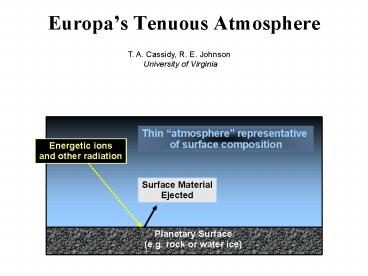Europas Tenuous Atmosphere PowerPoint PPT Presentation
Title: Europas Tenuous Atmosphere
1
Europas Tenuous Atmosphere
T. A. Cassidy, R. E. Johnson University of
Virginia
Thin atmosphere representative of surface
composition
Energetic ions and other radiation
Surface Material Ejected
Planetary Surface (e.g. rock or water ice)
2
Sodium Exospheres at Mercury and the Moon
Na in Absorption (Taken during Mercury's
transit of the Sun) Dawn Enhancement
Photodesorption
North
Dawn
Sunset
Mercury
SUN
Quarter Moon
Eclipsed Moon
Na in Emission Peak near subsolar point (due to
photodesorption)
3
Near-surface atmosphere model schematic
Atmosphere is marginally collisional
Launch Molecules
Stick or thermally desorb? Probability S
Molecules that dont stick are eventually lost to
space Molecule lifetime is measured in minutes
to days Of known or suspected atmospheric
constituents
4
1-D Atmosphere Model Results
Recent papers by Shematovich et al. Smyth and
Marconi
O2 and H2 created by radiolysis Johnson et al.,
1982
H2 quickly lost
O2 thermalized near the surface
O, H, OH created by electron-impact dissociation
of the atmosphere
Example from Smyth and Marconi, 2006
5
Neutral Clouds / Torus
The gravitationally unbound atmosphere
E.g., top-down view of Europas Na torus
E.g., side view of Europa O torus
Burger and Johnson, 2004
Smyth and Marconi, 2006
Europas torus is dominated by H2 and O,
detectable by its interaction with the
plasma. The Na torus is much more tenuous, but
detectable by ground based telescopes. There is
10X more material in the neutral torus than the
bound atmosphere
6
Brought to sea level on Earth, the neutral cloud
would occupy a cube 500 m per side.
Io has a larger neutral ejection rate, but Ios
torus slightly smaller (1/3 the of atoms and
molecules) due to faster ionization.
Burger and Johnson, 2004
7
Trace species And their spatial distribution
8
H2O Atmosphere
107
Thermal ions
106
Sputtering yields X Ion energy distribution
105
Sputtered H2O flux (cm-2s-1)
Non-thermal ions
104
103
102
103
104
105
106
107
S ion energy (eV)
- High-energy ions dominate sputtering.
- Such ions precipitate uniformly
- (because of their long bounce times)
- Paranicas et al., 2002
- Thus H2O ejection is roughly uniform over the
surface. - (Thermal desorption contributes much less
negligible at this scale)
H2O vertical column density
9
Trace species carried off with H2O
Porco et al. (2003) Cassidy et al. (2008)
Cassini ISS NAC Europas visible aurora Sum of 9
images of Europa in eclipse
Europas surface from same perspective
This is the only such observation available
10
Aurorae
O2 Aurora HST UV, 1356Å (same perspective)
Visible wavelength from previous slide
McGrath et al. (2004) Cassidy et al. (2007)
Plasma or neutrals?
Reminder brightness (neutral column
density)X(rate coeff.)X(electron density)
11
Saur et al. (1998) McGrath et al. (2004)
Saur et al. model A plasma simulation that
assumed a fairly uniform O2 atmosphere
My approach assume brightness variations are due
(mostly) to neutral density variations
12
O2 UV Aurora
Visible aurora
Surface image (same perspective as obs)
Simulations
O2 simulation O2 reacts with dark terrain
Na simulation Na ejected from dark terrain
13
But the neutral only approach is insufficient It
cannot explain temporal variability (Hansen et
al., 2005) and ignores the complex plasma
environment in Europas wake.
14
Plasma models
Plasma properties generally speaking, plasma
gets much more dense and slightly colder near the
surface
Kabin et al., 1999/Liu et al., 2000
Saur et al., 1998
MHD model Focused on large-scale plasma
properties Assumed constant neutral density
Focused on O2/electron interaction Assumed
constant magnetic field
Neutral models Include more species and
reactions, but neglect feedback to plasma
15
- Different models have different assumptions
- O2 scale height near the surfacewhat is the
relationship between neutral density and plasma
density? - Electron temperature near the surface
- 0.5 eV to 20 eV have been used in models
Example rate coefficient for electron-impact
process (1356 Å emission from O2) Note Rate
(s-1) (rate coefficient)x(electron density)
Rate Coefficient (cm3s-1)
16
Ios interaction
HST
1012 watts of mostly UV light
Jupiters rotating magnetic field Conduction
provided by plasma
Jupiter
Io
Cassini
From Russell et al., 2000 There is no such thing
as a unipolar inductor
17
The time-variable Na torus/atmosphere
Night on leading Na accumulates
Dawn on Leading Na desorbs
Orbit
Plasma ejects Na from trailing hem.
Leading hem.
Sunlight
18
In-situ Detection of Trace Species
Model ionosphere Placed trace species in
surface to see what would be detectable. Ion
detection A mass spectrometer in orbit could
detect as few as 1x10-3 ions/cm3. Neutral
detection Na could be easily detected.
Johnson et al., 1998

